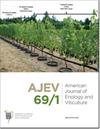用Alambic蒸馏
IF 1.8
3区 农林科学
Q3 BIOTECHNOLOGY & APPLIED MICROBIOLOGY
引用次数: 91
摘要
1989年6月30日,Robert Leaute在加利福尼亚州阿纳海姆举行的第40届美国酿酒和葡萄栽培学会年会上发表了James F. Guymon讲座。劳埃特自1973年以来一直在人头马工作,目前担任干邑总监、研发经理和RMS葡萄园技术顾问。他的报告文本已经编辑出版,但没有经过正常的审查程序。本文章由计算机程序翻译,如有差异,请以英文原文为准。
Distillation in Alambic
Robert Leaute presented the James F. Guymon Lecture at the 40th Annual Meeting of the American Society for Enology and Viticulture in Anaheim, California, on 30 June 1989. Leaute has been with Remy Martin since 1973 and is currently Head Cognac Master, Research and Development Manager, and RMS Vineyards Technical Advisor. The text of his presentation has been edited for publication, but not subjected to the normal review process.
求助全文
通过发布文献求助,成功后即可免费获取论文全文。
去求助
来源期刊

American Journal of Enology and Viticulture
农林科学-生物工程与应用微生物
CiteScore
3.80
自引率
10.50%
发文量
27
审稿时长
12-24 weeks
期刊介绍:
The American Journal of Enology and Viticulture (AJEV), published quarterly, is an official journal of the American Society for Enology and Viticulture (ASEV) and is the premier journal in the English language dedicated to scientific research on winemaking and grapegrowing. AJEV publishes full-length research papers, literature reviews, research notes, and technical briefs on various aspects of enology and viticulture, including wine chemistry, sensory science, process engineering, wine quality assessments, microbiology, methods development, plant pathogenesis, diseases and pests of grape, rootstock and clonal evaluation, effect of field practices, and grape genetics and breeding. All papers are peer reviewed, and authorship of papers is not limited to members of ASEV. The science editor, along with the viticulture, enology, and associate editors, are drawn from academic and research institutions worldwide and guide the content of the Journal.
 求助内容:
求助内容: 应助结果提醒方式:
应助结果提醒方式:


